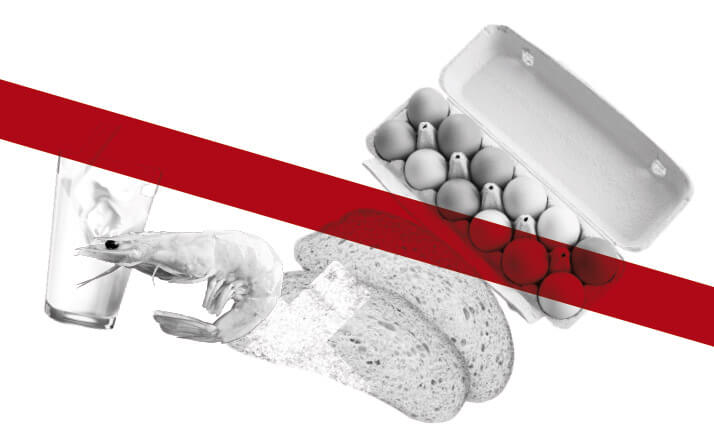Lauren Jackson is Acting Chief of the Food Chemistry and Nutrition Team at FDA/CFSAN located in Bedford Park, IL, USA. Lauren received her B.S. in Food Science from Cornell University, and her M.S. and PhD, both in Food Science, from the University of Wisconsin. Her expertise is in the area of processing and its affects on chemical contaminants and bioactive food components. Lauren is a member of ACS, IFT, IAFP and AOAC and serves as a scientific editor for the Journal of Food Science. “I’m currently working on several projects aimed at developing best practices for detecting and controlling food allergens.”


Food allergies represent an important health problem in industrialized nations, affecting an estimated 10-12 million people in the US alone (1). Some data indicate that the prevalence of food allergies appears to have risen in recent years, particularly in children (2, 3, 4). Preventative medical treatments are not available for individuals with food allergies, so strict avoidance of the allergy-causing food is currently the only means of avoiding a reaction – consumers must rely on accurate labeling of foods. However, allergenic proteins can be introduced into food due to labeling errors, improper handling of rework, cross-contact during and after processing, and incomplete cleaning of food processing equipment (5).
Legislation has been implemented to protect the food-allergic consumer. In the US, the Food Allergen Labeling and Consumer Protection Act (FALCPA) of 2004 requires food labels to clearly state if a food product or ingredient is, or contains, one or more of the eight major allergenic foods, namely milk, peanut, egg, tree nut, soy, wheat, crustacean shellfish and fish. More recent legislation in the US goes even further to protect those individuals with food allergies. The 'Proposed Rule for Preventative Controls for Human Food’ issued under the Food Safety Modernization Act (FSMA) proposes that food manufacturing facilities have a written safety plan that requires the identification of preventative controls for food allergens, and establishment of monitoring and verification procedures to ensure that the preventative controls are correctly implemented (6). Analytical methods to detect and quantify the presence of allergens in foods, ingredients and in the food processing environment are essential for establishing and supporting preventative control procedures for the industry, and for development of compliance and enforcement activities for regulatory agencies.
Analytical methods currently used for the detection of potential allergens in foods target either the allergen itself or markers that indicate the presence of the offending food, such as specific proteins, peptides and DNA fragments. However, the ability to detect and quantify these markers is affected by the composition of the food and the manner in which the food has been processed. There are situations where allergens may be present in concentrations that are capable of eliciting allergic reactions, yet are not detectable by established analytical methods because of food matrix components that affect the extraction and detection of analytes (7). In addition, some analytes, particularly proteins, are susceptible to chemical and thermal modifications that occur during food processing, rendering them undetectable with established methods. The most commonly used method for detecting and quantifying allergenic or marker proteins are immunochemical in nature, and include enzyme-linked immunosorbent assays (ELISA) and dipsticks or lateral flow devices (LFD). These systems are able to detect and/or quantify most of the eight major allergenic foods and typically have detection limits in the low µg/g (ppm) range. While ELISA assays and dipsticks are generally considered to be accurate, reliable, simple to operate and rapid, they do have drawbacks. Since immunochemical detection is achieved through binding of target protein(s) with antibodies, any changes in the binding properties (immunoreactivity) of the target proteins will influence assay results. Hydrolysis, thermal denaturation, and exposure to oxidizing chemicals, for example, some sanitizers, can change the immunoreactivity and solubility of proteins, and render them undetectable by immunochemical techniques. DNA-based detection methods are currently used to detect the presence of allergenic foods or ingredients when immunochemical methods are not available, or when confirmation of results from immunochemical assays is needed. DNA-based methods have the advantage of being highly specific and rapid, and are very useful for detecting allergenic foods in which protein is present in low concentrations. A disadvantage is that while DNA is a marker for the presence of allergenic food, detection of DNA does not necessarily mean that the allergenic proteins are present in sufficient quantities to elicit allergic reactions. Furthermore, information is limited on how processing of food affects detection of DNA. An emerging strategy for detection of food allergen proteins is by LC-MS/MS. Although the use of MS increases the price, time and complexity of analysis, advantages of this technique are provided by its specificity, selectivity, and suitability for multiplexing, which is the simultaneous detection of multiple proteins or peptides. Proteins, modified by thermal processing, hydrolysis or oxidation, can still be detected through LC-MS/MS, making this method a very powerful method for confirming results of more rapid immunochemical and DNA-based tests. Food allergen detection methods have advanced dramatically in the past ten years, resulting in new strategies, such as LC-MS/MS, and improvements in traditional analyses, for example, immunochemical analysis. Despite these advances, there are several obstacles that limit the effectiveness of allergen detection methods. Such challenges include the need to characterize how components of the food matrix influence extraction/detection of allergens. There is also a critical need to identify how allergens change during food manufacture to enable selection of the stable allergen marker molecules that survive food processing. Finally, further research is needed to develop appropriate food reference materials that could be used to calibrate allergen detection methods. Overcoming these research challenges will ultimately result in development of more reliable and accurate allergen detection methods that could be used to better protect the food-allergic consumer and for compliance purposes by regulatory agencies.
Please read the other articles in this series:
Non-Targeted Analysis
Foodomics
Electronic Senses
Emerging Contaminants
Lauren S. Jackson is at the Division of Food Processing Science & Technology, Institute for Food Safety and Health, Food and Drug Administration, Bedford Park, IL, USA.
References
- S. Sicherer et al., “Prevalence of seafood allergy in the United States determined by a random telephone survey”, J. Allergy Clin Immunol 114, 159-165 (2004) A. M. Branum, S. L. Lukacs, “Food allergy among US children: Trends in prevalence and hospitalizations”, NCHS Data Brief, Centers for Disease Control and Prevention October, 2008. S. Cochrane et al., “Factors influencing the incidence and prevalence of food allergy”, Allergy, 64, 1246-1255 (2009). S. H. Sicherer, A. Munoz-Furlong and H. A. Sampson, “Prevalence of peanut and tree nut allergy in the United States determined by means of a random digit dial telephone survey: a 5-year follow-up study”, J. Allergy Clin. Immunol. 112, 1203-1207 (2003). L. S. Jackson et al., “Cleaning and other control and validation strategies to prevent allergen cross-contact in food processing operations” J. Food Prot. 71, 445-458 (2008). U.S. Food and Drug Administration. The New FDA Food Safety Modernization Act (FSMA). http://www.fda.gov/Food/FoodSafety/FSMA/default.htm. Accessed 20/1/13. A. J. Van Hengel, “Food allergen detection methods and the challenge to protect food-allergenic consumers”, Anal. Bioanal. Chem. 389, 111-118 (2007).




